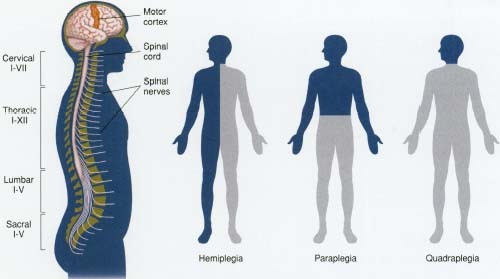The nerve damage that causes paralysis may be in the brain or spinal cord (the central nervous system) or it may be in the nerves outside the spinal cord (the peripheral nervous system). The most common causes of damage to the brain are:
stroke
tumor
trauma (caused by a fall or a blow)
Multiple sclerosis (a disease that destroys the protective sheath covering nerve cells)
cerebral palsy (a condition caused by a defect or injury to the brain that occurs at or shortly after birth)
metabolic disorder (a disorder that interferes with the body's ability to maintain itself)
Damage to the spinal cord is most often caused by trauma, such as a fall or a car crash. Other conditions that may damage nerves within or immediately adjacent to the spine include:
tumor
herniated disk (also called a ruptured or slipped disk)
spondylosis (a disease that causes stiffness in the joints of the spine)
rheumatoid arthritis of the spine
neurodegenerative disease (a disease that damages nerve cells)
multiple sclerosis
Damage to peripheral nerves may be caused by:
trauma
compression or entrapment (such as carpal tunnel syndrome)
Guillain-Barré syndrome (a disease of the nerves that sometimes follows fever caused by a viral infection or immunization)
chronic inflammatory demyelinating polyradiculoneuropathy (CIDP) (a condition that causes pain and swelling in the protective sheath covering nerve cells)
radiation
inherited demyelinating disease (a condition that destroys the protective sheath around the nerve cell)
toxins or poisons



 Contact Us
Contact Us






 Hospitals
Hospitals
 Doctors
Doctors
 Diagnostic
Diagnostic
 Pharmacy
Pharmacy
 Health Tips
Health Tips
 Blog
Blog

























Comments